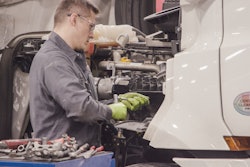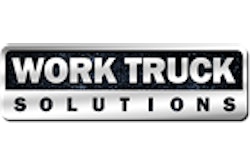
Inflation and sales uncertainty loom as the top concerns for trucking’s supply chain entering 2024, as manufacturers continue navigating post-pandemic business challenges and a downswing in the general economy.
Similar to their customers in the dealer and aftermarket channels, trucking suppliers are not expecting the economy to plummet in 2024. Business has undoubtedly softened from the boom experienced in 2021 and 2022, but trucking and the greater economy avoided a recession in 2023. Many manufacturers within the industry anticipate 2024 to be similar.
Most concerns within the channel relate to discrepancies within top-line revenues and bottom-line earnings, as well as labor availability to maintain production levels without disruptions. Suppliers are eager to reduce price increases back to historical norms, both for their benefit and the benefit of their customers, and eliminate open positions across their businesses. Suppliers state doing both will best position them to adapt to any economic shifts that occur as the year progresses and into 2025.
[Download our state of the industry survey results!]
2023 results are misleading
Vendors are eager to wrangle inflation in 2024 due its negative influence on their balance sheets in 2023. According to supplier responders to a fall 2023 Trucks, Parts, Service reader survey, 60% of suppliers were on pace to complete last year with revenues at least 2% higher than 2022.
But that success was somewhat hollow.
Only 48% of those same responders claimed to be outpacing their yearly projections by at least that same 2% margin, with 30% saying they were on pace to finish at least 2% below their projections for the year. Furthermore, 81% of supplier responders stated they finished 2022 up at least 2% on 2021, which indicates last year’s market growth was still subdued compared to the prior year.
Revenues also varied by channel, with some vendors having more success supplying production lines and others posting higher numbers through the aftermarket.
“Our aftermarket and retail business are growing positively; I think by the end of the month we’ll post a pretty good year there,” Optronics President Brett Johnson told TPS in December. “On the OEM side, the best word I’ve found is sluggish. You really have to look within the segments.”
Johnson said Optronics’ OEM commercial business, such as Class 8 trucks and trailers, was outpacing its light- and medium-duty products and other industries that are more tied to individual consumer purchases.
 Hiring and retaining a quality workforce is a point of emphasis for many suppliers in 2024, including Link Mfg.Link Mfg.
Hiring and retaining a quality workforce is a point of emphasis for many suppliers in 2024, including Link Mfg.Link Mfg.
Mike Leakey, senior vice president of sales and marketing at Link Mfg., also said heavy-duty truck production was driving a good year for his business.
“We entered the year a little apprehensive about the overall economy, to be honest,” Leakey said in November. “We knew freight indicators were down but there was pent-up demand for trucks. We had planned for about a 300,000-unit new truck market and we’re going to come in close to 330,000. The market has been a lot stronger than expected.”
The aftermarket, however, has been softer for Link. “It’s not down significantly, but it’s definitely off from [2022] for us,” Leakey said.
Other suppliers also noted the benefits of the build pace in 2023.
“Build numbers were higher than what we’d forecast for both trucks and trailers, which helped us sell more product and outpace revenue from our plan,” ConMet's Brian Rieger, vice president, North America Sales told TPS in November. “We’ve grown most substantially in our wheel hubs product line, mainly in the aftermarket and with trailer OEMs.”
Capitalizing on new opportunities also proved useful for vendors last year.
“Our core business, the basic products we sell to legacy customers, that was a little bit flat,” Doleco President Ralph Abato said in November. “Where we’ve really had success is with some of our new products, and converting new customers.”
Adding new products was definitely a point of emphasis for suppliers in 2023. More than half (52%) of the supplier responders to the fall 2023 TPS reader survey expanded their product lines in 2023. Another 19% considered and expansion, while 26% were steady and only 4% of vendors reduced their product lines.
Purkeys has been expanding its sustainability product offerings in recent years and Sales Application Engineer Larry Rambeaux said those products were among the company’s fastest growing in 2023. “As carriers work to be more green, those products are seeing more interest and demand,” he told TPS in December.
Supply chain repairs continue
Adding product lines hasn’t come without challenges. Trucking’s supply chain is much more robust than it was a few years ago, but it’s still not impervious to break downs.
“If you go back to a year ago, the products we were having issues with then are not the ones we’re having issues with now,” David Schultz, Bendix's director of aftermarket business development told TPS in November. “Things have gotten better but we’re not back to pre-COVID performance levels.”
Schultz said Bendix’s supply chain is unquestionably stronger than it was in 2021 and the company has added and deepened relationships with raw material suppliers to ensure the fulfillment challenges it faced at that time won’t be replicated. But even with those efforts problems still arise.
“It’s been almost like Whack-a-Mole,” he said. “Something will get resolved one day and then a new issue pops up.”
At Pratt Industries, Director of Engineering Joel Schubach said his company also is leveraging new supplier relationships to raise its supply chain performance. “We’ve actually stayed with the new suppliers over some of our previous suppliers because they’ve served us well and continue to provide great customer service.”
Added STEMCO in November, “Through our learnings from the last couple of years, STEMCO has invested significant resources into new sourcing strategies to be able to better withstand future supply chain interruptions. These include near shoring of suppliers, dual sourcing components and undertaking the testing necessary to feel confident the quality standards of our products maintain at current levels or improve.”
Suppliers also are much more attentive to inconsistencies from their supply chain entering 2024.
Tyler Jones, CEO at leaf spring manufacturer EMCO Industries, told TPS in December that his company’s supply chain fulfillment rates have rebounded to pre-pandemic norms. Jones said his bigger concern moving forward isn’t availability as much as price. A short-term bubble hit steel scrap prices in 2023. EMCO was able to identify the bubble forming and move product in advance, and Jones said the company will try to do the same if similar market conditions materialize in 2024.
Abato also mentioned inflation as a challenge facing supply chain, but states global freight is larger headache for Doleco. When container rates rose to astronomical highs in late 2021 and 2022, Abato said Doleco added them as a line item to invoices instead of a price increase, and thus were able to remove them from invoices when shipping rates fell back in line.
Abato hopes those rates remain steady in 2024 so the company doesn’t have to consider another line item or corresponding price adjustment.
STEMCO has a similar goal, with the company stating it is “committed to execution in our supply chain strategies in an effort to offset increased costs where possible going forward.”
What’s to come for 2024?
In looking ahead, most suppliers aren’t exactly optimistic about 2024, but they finally know what they’re up against. Truck production is expected to be flat or down, with aftermarket sales creeping up only slightly when adjusted for inflation. Suppliers will need to manage this year to position themselves for a hopeful economic upswing in 2025.
Among TPS supplier survey responders, only 41% of suppliers who support new truck production expect truck sales in 2024 to surpass 2023. In the trailer market, that number falls to 27%. Aftermarket confidence is higher; with 51% of supplier responders expecting OEM dealer aftermarket sales rising by at least 2% in 2024 and 59% expecting at least 2% increase in sales for the independent channel.
Vendors have muted optimism for their own businesses as well; 70% TPS supplier responders expect their company’s revenues to be up at least 2% in year over year but only 26% expect to be up at least 10%. Another 19% are predicting the year to be flat, with 11% expecting to be down by 2-10%.
Suppliers say external factors could have a large impact on market growth.
“I think the biggest challenge will be navigating the geopolitical and economic uncertainty going into 2024. It’s an election year, multiple wars, UAW strikes, inflation, shrinking logistic profits,” said Rieger. “It’s difficult to know how any of these factors will impact the economy, the supply chain, our business partners and customers. Any of those factors can affect the market negatively and inhibit our ability to sell products in the truck and trailer markets.”
As such, suppliers hope to capitalize on strong market pockets to support weakening in other areas.
 Purkeys' Larry Rambeaux says his company is optimistic for 2024 based on strong growth rates of new product lines. Rambeaux says the company is working to support the expanded business with product training and guidance.Purkeys
Purkeys' Larry Rambeaux says his company is optimistic for 2024 based on strong growth rates of new product lines. Rambeaux says the company is working to support the expanded business with product training and guidance.Purkeys
Rambeaux said Purkeys has customers with growth plans in 2024 that should enable the supplier to stave off a larger market downswing in production. Fontaine Spray Suppression finished 2023 with similar results compared to 2022 and is anticipating 2024 to be more of the same.
“Although the OEM truck and tanker build is forecasted to be down, our efforts in the aftermarket are offsetting that reduction,” the company stated in December.
Bendix has a similar outlook.
“We are expecting the OE side for 2024 to be lower than 2023,” Schultz said. “There are all kinds of indicators pointing toward a potential recession.”
A downswing could also impact the aftermarket, though Schultz acknowledged the channel still has pent-up demand that could be captured if equipment production slips. A slowdown “could allow us to catch up and give us a little capacity we could build for the aftermarket,” he said.
And reaching capacity remains a supplier challenge, mostly due to workforce issues.
“Workforce continues to be a challenge,” said Jones. “We are 100% in growth mode and have been for some time. Managing growth creates its own challenges.”
“Finding and keeping a skilled workforce is a challenge for all domestic manufacturers,” added Marcus Hester, president at EMCO. “We are increasing our investments in automation, and investing in our employee benefits and making our company a better place to work.”
Link is making investments across its operations to sustain its Iowa manufacturing facilities, said Leakey, while Fontaine Spray Suppression also expects “similar challenges with finding new employees to add to the workforce.”
“All across manufacturing there is a tremendous upward pressure on wages,” Leakey said. “We’re in a small town with 9,000 people. Our county has a 1-2% unemployment rate. To compete with other employers in our area, we have to think about what other intangible things can we offer?”
“Labor is a battle for most companies these days, and we’re no exception,” added ConMet's Tim Caplice, vice president of human resources. “Attracting and retaining talented employees is a major challenge, but we have worked hard at all of our locations to proactively implement the right actions to both attract and retain talented employees.”
“It’s the one challenge for every company, all the time, throughout history,” said Johnson. “The difficulty of finding the right people.”
Like other suppliers, Johnson said Optronics has adjusted its pay scale and bolstered its benefits packages to recruit and keep good employees. The company has even rolled out hybrid scheduling to accommodate remote work, as well as four-day work weeks (with 10-hour shifts) for warehouse associates. Johnson was initially hesitant to make the changes but acknowledged it was the right move for the company.
“I was not a proponent of it, but I am now. I’ve seen the light,” he said. “We are all about improving the Optronics employment brand.”
This is Part 3 of Trucks, Parts, Service's three-part industry status report entering 2024. Part I focused on the dealer channel and Part 2 addresses the aftermarket sector.











